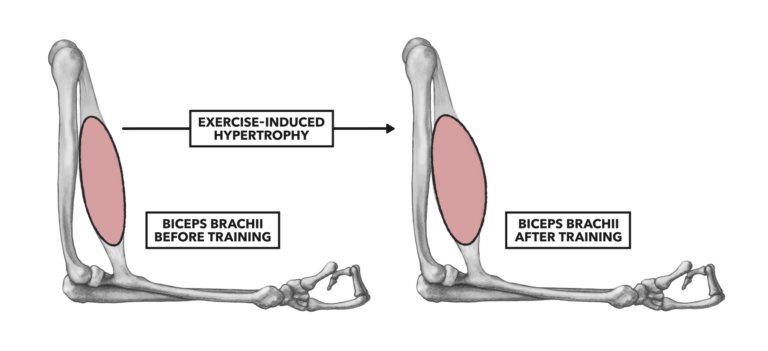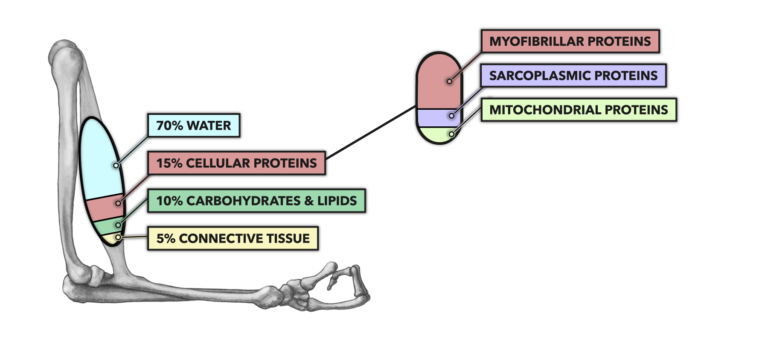The physiological process of increasing the size of an entire muscle is known as hypertrophy. Human muscle has a huge capacity for hypertrophy and is able to increase in size by 200% or more. A person maintains this ability throughout his or her lifespan.
Hypertrophy is considered a fairly straightforward process that adds thickness to muscle. Adding girth to muscle is also known as increasing cross-sectional area. Muscles get bigger in circumference; despite the claims from some exercise systems, muscles do not get bigger by becoming longer (other than in pediatric growth) since the distance between skeletal attachments cannot be extended by exercise.

Figure 1: Muscle hypertrophy
Although conceptually simple, the precise mechanism behind muscle growth largely is not understood. We know a good amount about the individual cellular players. However, the ways in which those players interact to contribute to cell and muscle growth are often debated to no resolution because there is very little quality research that provides definitive answers. In fact, there are numerous and differing methods for measuring hypertrophy and similarly many different laboratory models used to mimic real-world hypertrophy. These various methods and models create discord within the data.
A basic concept with robust support is that in order to increase muscle cross-sectional area, individual cells within the muscle enlarge and cumulatively increase the size of the complete muscle (1). Cellular hypertrophy results in whole-muscle hypertrophy.
A secondary route to muscle hypertrophy is through hyperplasia, where one muscle cells divides into two (basically mitosis) or a new cell is created from a progenitor cell. Hypertrophy through this mechanism occurs via increased cell number. Research on hyperplasia is not strong — if it does occur, it may be only a transient step in satellite cell fusion into an existing cell, or at best, a contributor of only about 3% toward overall muscle hypertrophy.
What Gets Added?
When we look at the chemical composition of whole muscle, we find there are four basic groups of components: (1) water, (2) cellular proteins, (3) carbohydrate and lipids, and (4) connective tissue proteins. Adding to any of these components can positively affect muscle hypertrophy.

Figure 2: The four components of a muscle
We see a similar distribution of components at the level of the individual muscle cell. If we look at which proteins are present inside individual muscle cells, we see a separation into three categories: (1) myofibrillar proteins, such as myosin, actin, titin, and more than a dozen more; (2) sarcoplasmic proteins, such as creatine kinase, lactate dehydrogenase, pyruvate kinase, myoglobin, and about 80 more; and (3) mitochondrial proteins, such as citrate synthase, ATP-synthase, cytochrome-C, and many more.
The composition of the increase in cellular mass is dependent on the type of training performed. Higher-intensity training is most likely to result in myofibrillar hypertrophy, whereas architectural and contractile protein additions provide the lion’s share of increased muscle mass. Lower-intensity and exhaustive exercise will most likely result in sarcoplasmic hypertrophy, where the added mass results from increased intracellular energy stores, increased presence of metabolic chemicals, increased mitochondrial content, and augmentation of other metabolic elements. It is important to note that this is not a black-and-white, either-or circumstance — myofibrillar and sarcoplasmic component additions occur in both types of hypertrophy, though there tends to be a bias toward one or the other end of the continuum. It is also important to understand the concepts of myofibrillar and sarcoplasmic hypertrophy are based upon conjecture. The weakness of the body of evidence related to hypertrophic mechanisms allows no more.
Reference
- Gollnick, P.D., B.F. Timson, R.L. Moore, and M. Riedy. Muscular enlargement and number of fibers in skeletal muscles of rats. Journal of Applied Physiology. 50(1981): 936–943.
Additional Reading
- Muscle Basics, Part 1: Cells, Proteins, and Sarcomeres
- Muscle Basics, Part 2: Anatomy of Muscle Contraction
To learn more about human movement and the CrossFit methodology, visit CrossFit Training.